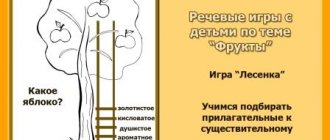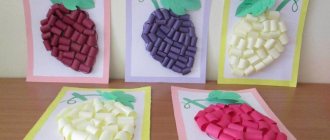Game-competition “Gifts of Autumn” on the topic: “Vegetables and fruits”
Gomzyakova Irina Nikolaevna Bogatyreva Elena Veniaminovna teachers MBDOU "Kindergarten of a combined type "Teremok" Borisovka village, Belgorod region
The material was sent for publication in the All-Russian printed collection of practice-oriented materials “Preschool and primary education - modern methods and technologies of teaching and upbringing” - SEPTEMBER 2021.
COMPETITION GAME “GIFTS OF AUTUMN” ON THE TOPIC: “VEGETABLES AND FRUITS”
Goal : Generalization and systematization of children’s knowledge about vegetables and fruits.
Advertising message
General education : to develop children’s knowledge about fruits and vegetables, to consolidate the general concepts of “vegetables” and “fruits”;
Developmental : develop attention, imagination, creative thinking, creativity, activate the child’s vocabulary, introduce a new word “TASTE”, develop the ability to solve riddles, select the right word, answer questions;
Educational : cultivate the ability to listen and respect the opinions of your comrades, contribute to the formation of a children's team.
Preliminary work:
- Learning the poem “Gifts of Autumn.”
- Guessing riddles.
- Making crafts from natural materials.
Materials for the lesson:
cut-out pictures for each table on the topic: vegetables, fruits; 2 scarves; diplomas; cups with pieces of fruits and vegetables; aprons, pots and ladles; colour pencils; a bag of vegetables and fruits; 2 cars and baskets; bumps.
Event plan:
- Introductory speech by the presenter (poem, distribution into teams, introduction to the rules of the game...)
- Competition stages:
- School for the Curious
- Vegetables and fruits
- Harvest the harvest
- Tops and roots
- Fun coloring book
- Magic bag
- Transport the harvest
- Cooks
- Taster
- Summing up the results of the game, rewarding.
Progress of the event:
- - Dear Guys! Now I’ll tell you a riddle, and you try to guess it:
“I came without paints and without a brush. And repainted all the leaves.” – What do you think this riddle is about? (about autumn)
- That's right, guys. Today we all gathered here not by chance, but to talk about this interesting time of year - about autumn.
– What is autumn like? Describe it (beautiful, sad, rainy, cold...). – And she’s also generous! After all, she does not come to us empty-handed... - What do we collect in the fall? (harvest). - What is the harvest? (vegetables, fruits, mushrooms, nuts)
- Guys, our girls have prepared a poem for you called “Gifts of Autumn.” Listen to him.
1 child: Hello, Autumn! How are you? What did you bring as a gift? – I brought you vegetables, just a treat. Rich in vitamins My treat for you!
2nd child: If you go into the garden, you will find vegetables there. There are potatoes and tomatoes, pepper, cucumber, salad. If you find yourself in the forest, you will find mushrooms and berries!
3rd child: Take the baskets, collect my gifts! If you go to the garden - wow! I brought you fruits - Pears, apples and melons, I don’t know their taste more wonderful.
- Well done, girls! Guys, what is this poem about? (about fruits and vegetables) -Where do fruits grow? (in the garden) -Where do vegetables grow? (in the garden) - I see that you know a lot about autumn, about fruits and vegetables.
Guys! I propose today to arrange a game-competition and find out who knows more about vegetables and fruits. To do this we need to split into 2 teams.
(Children take turns taking out dummies of vegetables or fruits from a wonderful bag).
– We will now guess what you name your teams:
– Shine on the satin skin. Stop! There is a traffic light in the garden! It shines bright red Juicy ripe... (tomato).
The first team will be called "Tomato".
– We have teams, but who will evaluate us? Who will decide the winning team? (Jury!)
– We present to you our strict jury.
– Now let’s remember the rules of the game:
- Questions are asked to the teams in turn.
- Don't interrupt each other.
- Don't give any hints.
- For each correct answer, the Tomato team receives a vegetable, and the Orange team receives a fruit.
At the end of the game, the jury will count your fruits and vegetables. The team with the most vegetables or fruits will win. Is everyone clear? (Yes!)
– Are the teams ready to play? (Yes!) – Is the jury ready to evaluate us? (Yes!) Let's start playing!
- – The first stage of the game is called “School for the Curious.” I will ask one riddle to each team in turn. Only the team I contact responds. The rest are silent. If a team does not give the correct answer, then the right to answer passes to the next team...:
- Girlfriends live in a green hut. Like beads are round, emerald and small. (peas)
- Yellow, juicy honey fruit grows on a garden tree. (pear)
- Yellow Antoshka Spins on his leg. Where the sun stands, That's where he looks. (sunflower)
4.It is green, round, smooth. And inside it is red and sweet. (watermelon)
- Although it tastes bitter, But inside it is white and strong. And on a grater it is given to those who are sick. (radish)
- Just like a fist. Red barrel, If you touch it, it’s smooth, but if you bite it, it’s sweet (apple).
- An old grandfather is sitting, dressed in a golden fur coat. Whoever undresses him sheds tears. (onion)
- Believe it or not, we come from America. In the fairy tale we are seniors, in the garden... (tomatoes)
- I looked at the sun, became prettier and rounder. I’m not used to the cold, I’m not cabbage, but... (pumpkin)
- It’s not at all difficult to guess, anyone can guess! The leaf is elastic, emerald green and curls into the head. (cabbage)
- I am growing in the ground in a garden bed, red, long, sweet. (carrot)
- It’s unsightly, a little bumpy, but when it comes to the table, the guys will say cheerfully: “Oh, it’s crumbly, it’s delicious!” (potato)
– The second stage of the game “Vegetables and Fruits”. Each team receives cards, which they must quickly and correctly sort into two groups: vegetables and fruits. Collected - raised your hand so that we can see that you have completed the task. The team that collects it first and correctly will receive a vegetable or fruit. It's clear? (Yes!) Let's get started!
– Third competition “Gather the Harvest” . At the leader's command, you must collect as many cones as possible in one minute and put them in your container. The team that collects the most cones will win. But we collect only with our elbows, like this... It's clear? (Yes!) Let's get started!
Now let’s play the attentive game “Tops and Roots.” We will call the edible root of the vegetable roots, and the edible fruit on the stem - tops. I will name a vegetable and if it has an edible root, then you will sit down. And if the top is edible, then raise your hands up.
Carrots (roots), tomatoes (tops), onions (tops and roots) Potatoes (roots), cucumber (tops), beets (roots), parsley (tops), garlic (roots), peas (tops), pepper (tops) .
– The next stage is “Fun Coloring”. Teams receive 4 pictures. The task is to quickly and correctly color the offered vegetable, fruit, berry and mushroom on command. Is the task clear? (Yes!) Let's start!
Physical education minute.
Now let's do a little work in the garden. We got up and did everything together, in unison.
We dug up potatoes, picked cucumbers from the garden, (squats) pulled out all the carrots, (bent over) deftly cut the cabbage. And they brought you a gift in a basket from the earth. Let's continue our game.
– And for this competition ( “Magic Bag” ), volunteers from each team come to me, one from each team.
- Now I blindfold them. Assignment - I approach everyone in turn, they take out one item from my bag, feel it and name it. For each correct answer - a point. It's clear?
- Have you stayed too long, guys? I suggest you move a little, run... We move on to the “Transport the crop” stage. The teams line up behind the line. The task is to put one vegetable or fruit into your car on command, drive the car to the warehouse - basket, unload it and return empty to the team, passing the baton to the next participant, and so on until all the vegetables and fruits are in the warehouse... Is the task clear? (Yes!) Let's get started!
Competition "Cooks"
– And now you will turn into imaginary chefs and cook.
– Team “Orange”, what can you make from apples? (compote, jam, apple pies, salad)
Team “Tomato”, what can you cook from cabbage? (cabbage soup, stewed cabbage, cabbage salad, sauerkraut, cabbage pies, cabbage rolls, schnitzel, dumplings).
– This competition involves one cook at a time. On command, the cooks put on an apron, move the pan inside them, select the products they need, put them in the pan and lift the ladle up, showing us that the task has been completed. And they tell you what they have prepared. It's clear?
– This competition is called “Taster”. Who knows what this word means? Who do we call a taster?
– A taster is a person who can easily identify any object or substance by smell. For example: at a factory that produces perfume, a taster tastes - smells a new perfume and gives it a beautiful name based on its smell.
– Let’s all say the word taster together and remember what it means...
– For this competition, volunteers from each team come to me, one from each team...
- Now I blindfold them. Assignment - I approach each person in turn and offer to identify the product that is on the plate by smell. A token is given for the correct answer. It's clear? (Yes!) Let's get started!
- Our game has come to an end. And now the jury will sum up the results, count your fruits and vegetables and announce the winners...
- While the jury is counting, I suggest you play: if I name a vegetable. Then you stomp your feet, and if it’s fruit, you clap your hands. Let's get ready. Let's start!
– The floor is given to our jury.
Bibliography:
- Poems about autumn – https://www.stihomaniya.ru/2017/07/stixi-pro-dary-oseni.html
- T.A. Shorygina “Vegetables. What are they?”, Moscow, “Gnome and D”, 2007, p.83-84
- “Wonderful Box” (Russian folk songs, fairy tales, games, riddles), Moscow, “Children’s Literature”, 1988.
You can see the table of authors and learn more about the collections HERE
Card index of didactic games on the topic “Vegetables and fruits” card index (junior group)
Card index of didactic games on the topic “Fruits and vegetables”
1. Didactic game “Borscht or compote” Purpose: to teach how to classify vegetables and fruits, to introduce the specifics of preparing borscht and compote. Develop speech and memory. Game rules: Pictures of a “pan” and a “jar” are displayed on a board or easel. Children receive 2-3 subject pictures depicting vegetables and fruits. Each child, naming a picture, places it, respectively, either “in the borscht” (“in the pan”) or “in the compote” (in the “jar”).
2. Didactic game “Magic Chest” Purpose: Expand ideas about shape, size, color; develop skills in comparing objects. Material: Real fruits and vegetables, box with slot. Game rules: The teacher takes a bag and puts fruits and vegetables in it (mixes). All children are seated on chairs. Progress of the game. A willing child approaches the chest, puts his hand into the slot and feels for an object (fruit or vegetable) there. Further, without removing this object, he tries to guess what exactly he felt, using only tactile sensations.
3. Didactic game “Pick up clothes” Purpose: to form children’s ideas about vegetables and fruits (shape, color), develop speech, thinking, perception. Materials: multi-colored cards corresponding to certain colors of fruits and vegetables, stencils of fruits and vegetables. The child is given a stencil (fruit or vegetable), asked what this outline image looks like and asked to find “clothes” for it, i.e. imagine this fruit (vegetable) in reality and choose a characteristic color for it. Attach the stencil to the selected card, show the results and voice your choice.
4. Didactic game “The Fourth Extra” Goal: To consolidate the ability to find the fourth extra object and explain why it is extra. Objectives:• Develop verbal and logical thinking, the ability to classify, compare, generalize, establish cause-and-effect, spatio-temporal, logical connections.• Develop visual perception.• Develop monologue and dialogic speech.• Cultivate attentiveness Materials: cards with images of four objects, one of which does not fit the general classification. Assignment for children: find and name an extra object, explain why it is extra.
5. Didactic game “Tops and Roots”, Purpose: To consolidate knowledge that vegetables have edible roots - roots and fruits - tops, some vegetables have both tops and roots edible; practice assembling a whole plant from its parts. Game rules. You can look for your top or spine only when given a signal. You can’t pair up with the same player all the time; you have to look for another pair. Game actions. Search for a pair; composition of a whole plant. Progress of the game. Option 1. After harvesting in his garden, an adult gathers the children, showing them what a good harvest they have grown, praising them for their useful work. Then he clarifies the children’s knowledge that some plants have edible roots - roots, others have fruits - tops, and some plants have both tops and roots edible. An adult explains the rules of the game: “Today we will play a game called “Tops and Roots.” On our table are the tops and roots of plants—vegetables. We will now divide into two groups: one group will be called tops, and the other will be called roots. (Children are divided into two groups.) There are vegetables on the table; The children of the first group take the top in their hands, and the children of the second group take the spine. Have you taken everything? And now, at the signal (clap your hands), you will all scatter around the area and run in all directions. When you hear the signal “One, two, three - find your pair!”, quickly find a pair for yourself: the spine to your top. The game is repeated, but you have to look for another top (or spine). You can't be paired with the same player all the time. Option 2. The tops (or roots) stand still. Only one subgroup of guys is running around the site. The adult gives the signal: “Roots, find your tops!” Children should stand so that the tops and roots form one whole.
6. Didactic game “Guess by Description”, Purpose: to consolidate children’s knowledge about fruits and vegetables, develop imaginative thinking, memory, teach to establish logical connections, the ability to listen and analyze the teacher’s speech. Materials: dummies of fruits, vegetables or pictures of them. Game rules. A particular fruit or vegetable is clearly and clearly described to children, naming its characteristic features, features of use, etc. Children, analyzing the information received, try to guess what object they are talking about and name it. For the correct answer, the child receives some kind of reward (card, chip, etc.). The teacher shows the guessed fruit or vegetable and once again pronounces its features and properties
7. Didactic game “Guess by taste, smell” Purpose: to consolidate children’s knowledge about fruits and vegetables, develop sensory skills, taste cues, develop imaginative thinking, speech Materials: washed fruits and vegetables laid out on a tray, knife, napkins Game rules: children sit in a semicircle near a tray with vegetables and fruits. The teacher invites children to recognize this or that vegetable or fruit by smell or taste. A person is called and blindfolded. The teacher, in front of everyone, cuts off a piece from something lying on the tray. The child is allowed to smell this piece first. If you can’t recognize a fruit (vegetable) by smell, then give it a try. The child must name what it was. For the correct answer, the child receives some kind of reward (card, chip, etc.).
8. Didactic game “Fold the picture” Materials: cards size 15/15 with images of fruits and vegetables, cut into 4 parts. Goal: to teach children to make a whole from parts, based on color and shape. Know the names of vegetables and fruits. Game actions: First, several whole pictures are laid out in front of the children, on which vegetables and fruits are drawn. Then all the pictures are mixed. The task is given - to find the parts that make up the picture and put it together.


